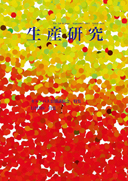Volume 67, Issue 5
Displaying 1-32 of 32 articles from this issue
- |<
- <
- 1
- >
- >|
Lectures at IIS Open Campus
-
2015 Volume 67 Issue 5 Pages 383-385
Published: September 01, 2015
Released on J-STAGE: October 05, 2015
Download PDF (918K) -
2015 Volume 67 Issue 5 Pages 387
Published: September 01, 2015
Released on J-STAGE: October 05, 2015
Download PDF (100K) -
2015 Volume 67 Issue 5 Pages 389-394
Published: September 01, 2015
Released on J-STAGE: October 05, 2015
Download PDF (347K) -
2015 Volume 67 Issue 5 Pages 395-403
Published: September 01, 2015
Released on J-STAGE: October 05, 2015
Download PDF (378K) -
2015 Volume 67 Issue 5 Pages 405-413
Published: September 01, 2015
Released on J-STAGE: October 05, 2015
Download PDF (456K) -
2015 Volume 67 Issue 5 Pages 415-424
Published: September 01, 2015
Released on J-STAGE: October 05, 2015
Download PDF (423K) -
2015 Volume 67 Issue 5 Pages 425-434
Published: September 01, 2015
Released on J-STAGE: October 05, 2015
Download PDF (403K) -
2015 Volume 67 Issue 5 Pages 435-440
Published: September 01, 2015
Released on J-STAGE: October 05, 2015
Download PDF (323K)
-
2015 Volume 67 Issue 5 Pages 441-446
Published: September 01, 2015
Released on J-STAGE: October 05, 2015
Download PDF (7780K) -
2015 Volume 67 Issue 5 Pages 447-452
Published: September 01, 2015
Released on J-STAGE: October 05, 2015
Download PDF (4030K) -
2015 Volume 67 Issue 5 Pages 453-456
Published: September 01, 2015
Released on J-STAGE: October 05, 2015
Download PDF (5162K) -
2015 Volume 67 Issue 5 Pages 457-460
Published: September 01, 2015
Released on J-STAGE: October 05, 2015
Download PDF (4770K) -
2015 Volume 67 Issue 5 Pages 461-465
Published: September 01, 2015
Released on J-STAGE: October 05, 2015
Download PDF (6590K)
Lectures at IIS Open Campus
-
2015 Volume 67 Issue 5 Pages 467-474
Published: September 01, 2015
Released on J-STAGE: October 05, 2015
Download PDF (2883K) -
2015 Volume 67 Issue 5 Pages 475-488
Published: September 01, 2015
Released on J-STAGE: October 05, 2015
Download PDF (24235K) -
2015 Volume 67 Issue 5 Pages 489-499
Published: September 01, 2015
Released on J-STAGE: October 05, 2015
Download PDF (14936K) -
2015 Volume 67 Issue 5 Pages 501-510
Published: September 01, 2015
Released on J-STAGE: October 05, 2015
Download PDF (6229K)
Introduction to Special Section
-
2015 Volume 67 Issue 5 Pages 511
Published: September 01, 2015
Released on J-STAGE: October 05, 2015
Download PDF (64K)
Research Flash
-
2015 Volume 67 Issue 5 Pages 513-516
Published: September 01, 2015
Released on J-STAGE: October 05, 2015
Download PDF (3653K) -
2015 Volume 67 Issue 5 Pages 517-519
Published: September 01, 2015
Released on J-STAGE: October 05, 2015
Download PDF (2487K) -
2015 Volume 67 Issue 5 Pages 521-524
Published: September 01, 2015
Released on J-STAGE: October 05, 2015
Download PDF (2291K)
Research Review
-
2015 Volume 67 Issue 5 Pages 525-530
Published: September 01, 2015
Released on J-STAGE: October 05, 2015
Download PDF (3417K) -
2015 Volume 67 Issue 5 Pages 531-537
Published: September 01, 2015
Released on J-STAGE: October 05, 2015
Download PDF (6264K) -
2015 Volume 67 Issue 5 Pages 539-544
Published: September 01, 2015
Released on J-STAGE: October 05, 2015
Download PDF (2141K) -
2015 Volume 67 Issue 5 Pages 545-550
Published: September 01, 2015
Released on J-STAGE: October 05, 2015
Download PDF (5773K) -
2015 Volume 67 Issue 5 Pages 551-557
Published: September 01, 2015
Released on J-STAGE: October 05, 2015
Download PDF (2158K) -
2015 Volume 67 Issue 5 Pages 559-563
Published: September 01, 2015
Released on J-STAGE: October 05, 2015
Download PDF (706K) -
2015 Volume 67 Issue 5 Pages 565-571
Published: September 01, 2015
Released on J-STAGE: October 05, 2015
Download PDF (6160K) -
2015 Volume 67 Issue 5 Pages 573-577
Published: September 01, 2015
Released on J-STAGE: October 05, 2015
Download PDF (2012K)
Laboratory Introduction
-
2015 Volume 67 Issue 5 Pages 579
Published: September 01, 2015
Released on J-STAGE: October 05, 2015
Download PDF (941K)
Research Review
-
2015 Volume 67 Issue 5 Pages 581-585
Published: September 01, 2015
Released on J-STAGE: October 05, 2015
Download PDF (2928K)
Laboratory Introduction
-
2015 Volume 67 Issue 5 Pages 587-598
Published: September 01, 2015
Released on J-STAGE: October 05, 2015
Download PDF (14471K)
- |<
- <
- 1
- >
- >|
